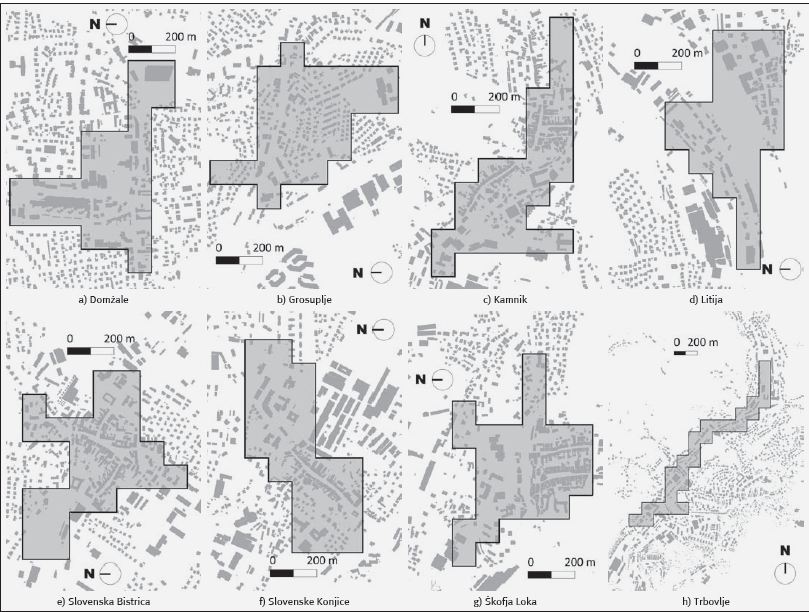The Impact of Public Open Space on the Image of Small Towns Centres in Slovenia
DOI:
https://doi.org/10.31522/p.31.2(66).1Keywords:
image of the city, public open space (POS), Slovenia, small towns, town centreAbstract
Despite all the principles of sustainable urban design, more and more spaces in small town centres are getting dedicated to traffic. Public open spaces (POS) in these towns are mainly reserved for car traffic, and social activities have been in decline. All at the expense of transportation space and built-up areas. As a result, there are fewer and fewer POS, which provide well-being and comfort to people, are accessible to all and are also attractively designed, allowing the development of a wide range of activities, and contributing to a town’s good image. Therefore, the aim of this paper is to determine the state of provision of POS in the centres of selected small towns in Slovenia and to assess the image of these town centres. Using various methods and instruments, we tested the hypothesis of whether there is a relationship between POS and the image of town centres. We used a cartographic method and a questionnaire survey, as well as statistical methods, in order to confirm the hypothesis. The study has revealed that groups of morphologically similar small towns are statistically different from each other in terms of observed relationships between POS and the image of the town centre. Therefore, a morphological analysis approach is very important in terms of evaluating the relationship between POS and the image of town centres. In conclusion, recommendations are given for the design of POS in small town centres.
References
Anholt, S. (2006) ‘The Anholt-GMI City Brands Index: How the World Sees the World’s Cities’. Place Branding and Public Diplomacy, 2(1), pp. 18-31. https://doi.org/10.1057/palgrave.pb.5990042
Brown, A. (ed.) (2006) Contested Space: Street Trading, Public Space, and Livelihoods in Developing Cities. 1st ed. Rugby: ITDG Publishing. https://doi.org/10.3362/9781780444703
Carmona, M.; Punter, J.V. and Chapman, D. (2002) From Design Policy to Design Quality: The Treatment of Design in Community Strategies, Local Development Frameworks and Action Plans. 1st ed. London: Thomas Telford Publishing.
Carmona, M.; de Magalhães, C. and Hammond, L. (2008) Public Space: The Management Dimension. 1st ed. Oxon: Routledge. https://doi.org/10.4324/9780203927229
Carmona, M. (2010) ‘Contemporary Public Space, Part Two: Classification’. Journal of Urban Design, 15(2), pp. 157-173. https://doi.org/10.1080/13574801003638111
Carr, S.; Francis, M.; Rivlin, L.G. and Stone, A.M. (1992) Public Space. 1st ed. Cambridge: Cambridge University Press.
CEMAT (2000) Guiding Principles for Sustainable Spatial Development of the European Continent. Adopted at the 12th Session of the European Conference of Ministers Responsible for Regional Planning on 7-8 September 2000 in Hannover [online]. Hannover: Council of Europe, pp. 25. Available at: /https://rm.coe.int/1680700173 [Accessed: 18.5.2023].
Čok, G. and Bolčič, J. (2018) ‘Protokol o celovitem upravljanju obalnih območij v Sredozemlju in sodelovanje javnosti pri prostorskih posegih v slovenskem obalnem pasu’. Annales: anali za istrske in mediteranske študije: Series historia et sociologia, 28(3), pp. 553-568.
Čok, G. and Furman Oman, M. (2019) ‘Working at Home as a Spatial Phenomenon - Architectural and Urbanistic Aspects of Regulating Working at Home’. Creativity Game: Theory and Practice of Spatial Planning, 7(2019), pp. 38-45. https://doi.org/10.15292/IU-CG.2019.07.038-045
Čok, G.; Mlakar, A.; Plazar Mlakar, M. and Repe. B. (2021) ‘Analiza načrtovanih prostorskih posegov v obalnem pasu Slovenije z vidika preobrazbe obstoječega stanja’. Annales: anali za istrske in mediteranske študije, Series historia et sociologia, 31(1), pp. 99-116.
Drozg, V. (1998) ‘Tlorisi slovenskih mest’. Geografski vestnik: časopis za geografijo in sorodne vede, 70(1998), pp. 75-90.
ESDP (1999) European Spatial Development Perspective: Towards Balanced and Sustainable Development of the Territory of the European Union [online]. Luxembourg: Office for Official Publications of the European Communities, 82 pages. Available at: https://op.europa.eu/en/publication-detail/-/publication/a8abd557-e346-4531-a6efe81d3d95027f/language-en/format-PDF/source-287285340 [Accessed:18.5.2023].
EU Charter (2000) Charter of Fundamental Rights of the European Union [online]. Brussels: Official Journal of the European Communities, 22 pages. Available at: https://www.europarl.europa.eu/charter/pdf/text_en.pdf [Accessed: 18.5.2023].
Fikfak, A.; Nikšič, M.; Černigoj, N.; Grom, J.P. and Konjar, M. (2020) Regulacijski elementi: priročnik. Ljubljana: Ministrstvo za okolje in prostor, Direktorat za prostor, graditev in stanovanja, 109 pages.
Gehl, J. (1996) Life between Buildings: Using Public Space. 1st ed. Skive: Arkitektens Forlarg.
Gehl, J. and Gemzø´e, L. (2000) New City Spaces. 1 st ed. Copenhagen: The Danish Architectural Press.
Gilboa, S.; Jaffe, E.D.; Vianelli, D.; Pastore, A. and Herstein, R. (2015) ‘A Summated Rating Scale for Measuring City Image’. Cities, 44, pp. 50-59. https://doi.org/10.1016/j.cities.2015.01.002
GURS (2016) Kataster nepremičnin, Kataster stavb, REN, DOF in drugi prostorski podatki [online]. RS, Ministrstvo za okolje in prostor, Geodetska uprava Republike Slovenije, Available at https://www.e-prostor.gov.si/ in https://pis.eprostor.gov.si/pis. [Accessed: 16.2.2018].
Jackson, J.B. (1984) The American Public Space. In: Glazer, N. and Lilla, M. (eds.) The Public Face of Architecture, Civic Culture and Public Spaces. 1st ed. New York: The Free Press, pp. 276-291.
Kalandides, A. (2011) ‘City marketing for Bogotá: A Case Study in Integrated Place Branding’. Journal of Place Management and Development, 4(3), pp. 282-291. https://doi.org/10.1108/17538331111176093
Khirfan, L. and Momani, B. (2013) ‘(Re)branding Amman: A ‘Lived’ City’s Values, Image and Identity’. Place Branding and Public Diplomacy, 9(1), pp. 49-65. https://doi.org/10.1057/pb.2013.1
Kohn, M. (2004) Brave New Neighbourhoods: The Privatization of Public Space. 1st ed. New York: Routledge. https://doi.org/10.4324/9780203495117
Kos, D. (2008) ‘Polivalentnost javnih mestnih prostorov’ [online]. Arhitektov bilten: AB: mednarodna revija za teorijo arhitekture, 38(177-178), pp. 60-61. Available at: https://www.dlib.si/details/URN:NBN:SI:doc-H9CR2BVS [Accessed: 18.5.2023].
Lavtižar, K.; Fikfak, A. and Grom J.P. (2023) ‘Dispersion of Traffic Pollutants in the Built Environment’. Prostor, 31(1/65/), pp. 28-37. https://doi.org/10.31522/p.31.1(65).3
Lofland, L.H. (1998) The Public Realm: Exploring the City’s Quintessential Social Territory. 1st ed. New York: Aldine de Gruyter.
Lynch, K. (1960) The Image of the City. 1st ed. Cambridge, Massachusetts, London: MIT Press. Ministrstvo za notranje zadeve - MNZ (2018) Agregirani podatki o številu stalno in začasno prijavljenih oseb na identifikacijsko številko navedene občine. RS, Ministrstvo za notranje zadeve, stanje na dan: 14.5.2018.
Nared, J.; Bole, D.; Breg Valjavec, M.; Ciglič, R.; Černič Istenič, M.; Goluža, M.; Kozina, J.;
Lapuh, L.; Razpotnik Visković, N.; Repolusk, P.; Rus, P. and Tiran, J. (2016) Policentrično omrežje središč in dostopnost prebivalstva do storitev splošnega in splošnega gospodarskega pomena’ [Research report]. Ljubljana: Znanstvenoraziskovalni center Slovenske akademije znanosti in umetnosti.
Nasar, J.L. (1998) The Evaluative Image of the City. 1st ed. London: SAGE Publications.
Nikšič, M.; Šifkovič Vrbica, S. and Jankovič, L. (2021) Javne odprte grajene površine. Priročnik. Ljubljana: Ministrstvo za okolje in prostor, Direktorat za prostor, graditev in stanovanja.
Parkerson, B. and Saunders, J. (2005) ‘City Branding: Can Goods and Services Branding Models Be Used to Brand Cities?’. Place Branding and Public Diplomacy, 1(3), pp. 242-264. https://doi.org/10.1057/palgrave.pb.5990026
Rebernik, D. (2010) ‘Teorija in praksa prostorskega načrtovanja: prostorski razvoj mest in širših mestnih območij v Sloveniji’, Dela, 33, pp. 111-127. https://doi.org/10.4312/dela.33.111-127
Robertson, K.A. (1999) ‘Can Small-City Downtowns Remain Viable?’. Journal of the American Planning Association, 65(3), pp. 270-283. https://doi.org/10.1080/01944369908976057
Robertson, K.A. (2001) ‘Downtown Development Principles for Small Cities’. In: Burayidi, M.A. (ed.) Downtowns: Revitalizing the Centers of Small Urban Communities. New York: Routledge.
Scruton, R. (1984) ‘Public Space and the Classical Vernacular’. In: Glazer, N. and Lilla, M. (eds.) The Public Face of Architecture, Civic Culture and Public Spaces. 1st ed. New York: The Free Press, pp. 13-25.
SeGI (2013) Services of General Interests: a European Issue [online]. Luxembourg: ESPON 2013 Programme. Available at: https://www.espon.eu/topics-policy/publications/evidence-briefs/services-general-interest-europeanissue [Accessed: 18.5.2023].
Sopina, A. and Bojanić Obad Šćitaroci, B. (2019) ‘Connecting City and Landscape: Urbanism and Landscape Point of View’, Prostor, 27 (2/58/), pp. 270-283. https://doi.org/10.31522/p.27.2(58).7
Speck, J. (2012) Walkable City: How Downtown Can Save America, One Step at a Time. 1st ed. New York: Farrar, Straus and Giroux.
Staeheli, L. and Mitchell, D. (2008) The People’s Property?: Power, Politics, and the Public. New York: Routledge.
Territorial Agenda 2030 (2020) A Future for All Places [online]. Informal Meeting of Ministers Responsible for Spatial Planning, Territorial Development and/or Territorial Cohesion, 1 December 2020, Germany. Available at: https://territorialagenda.eu/wpcontent/uploads/TA2030_jun2021_en.pdf [Accessed: 18.5.2023].
Tibbalds, F. (1992) Making People-friendly Towns: Improving the Public Environment in Towns and Cities. 1st ed. Harlow: Longman.
The New Charter of Athens (2003) The European Council of Town Planners’ Vision for Cities in the 21st century [online]. European Council of Town Planners. Lisbon: European Council of Town Planners. Available at: https://archive.ectp-ceu.eu/ectp-ceu.eu/images/stories/ download/charter2003.pdf [Accessed: 18.5.2023].
The New Urban Agenda (2017) [online] Adopted at the United Nations Conference on Housing and Sustainable Urban Development (Habitat III) in Quito, Ecuador, on 20 October 2016. Available at: https://habitat3.org/wp-content/uploads/NUA-English.pdf [Accessed: 2.3.2023].
Treaty of Lisbon (2007) Treaty of Lisbon Amending the Treaty on European Union and the Treaty Establishing the European Community, signed at Lisbon,13 December 2007 [online]. Official Journal of the European Union C 306, Vol. 50. Available at: https://eur-lex.europa.eu/legal-content/EN/TXT/PDF/?uri=OJ:C:2007:306:FULL [Accessed: 18.5.2023].
Vertelj Nared, P. and Zavodnik Lamovšek, A. (2015) ‘Public Open Space as a Contribution to Urban Development in Small Slovenian Cities’, Urbani izziv, 26 (special issue, suppl.), p.p. 114-129. https://doi.org/10.5379/urbani-izziven-2015-26-supplement-008
Volgemut, M.; Fikfak, A. and Zavodnik Lamovšek, A. (2021) ‘Pomen odprtega javnega prostora v središčih majhnih mest z vidika izvajanja storitev splošnega pomena’. Annales: anali za istrske in mediteranske študije: Series historia et sociologia, 31(1), pp. 83-98.
Zavodnik Lamovšek, A.; Drobne, S. and Žaucer, T. (2008) ‘Small and Medium-size Towns as the Basis of Polycentric Urban Development = Majhna in srednje velika mesta kot ogrodje policentričnega urbanega razvoja’ [online]. Geodetski vestnik : glasilo Zveze geodetov Slovenije, 52(2), pp. 267-289. Available at: http://www.geodetski-vestnik.com/52/2/gv52-2_290-312.pdf [Accessed: 18.5.2023].
ZUreP-3 (2021) ‘Zakon o urejanju prostora - 3’. Uradni list RS, št. 199/21, 18/23.
Zukin, S. (1995) The Cultures of Cities. 1st ed. Oxford, Cambridge: Blackwell Publishers.

Downloads
Published
How to Cite
Issue
Section
License
Copyright (c) 2023 Mateja Volgemut, Alenka Fikfak, Alma Zavodnik Lamovšek

This work is licensed under a Creative Commons Attribution 4.0 International License.
Copyright (c) 2021 authors and journal.
This work is licensed under a Creative Commons Attribution 4.0 International License.
Authors who publish with this journal agree to the following terms:
In agreeing this form, you certify that:
- You read the ethical codex of the PROSTOR available at journal web.
- You submitted work is your original work, and has not previously been published and does not include any form of plagiarism.
- You own copyright in the submitted work, and are therefore permitted to assign the licence to publish to PROSTOR.
- Your submitted work contains no violation of any existing copyright or other third party right or any material of an obscene, libellous or otherwise unlawful nature.
- You have obtained permission for and acknowledged the source of any illustrations, diagrams or other material included in the work of which you are not the copyright owner.
- You have taken due care to ensure the accuracy of the work, and that, to the best of your knowledge, there are no false statements made within it.
- All co-authors of this submitted work are aware of, and in agreement with, the terms of this licence and that the submitted manuscript has been approved by these authors.






